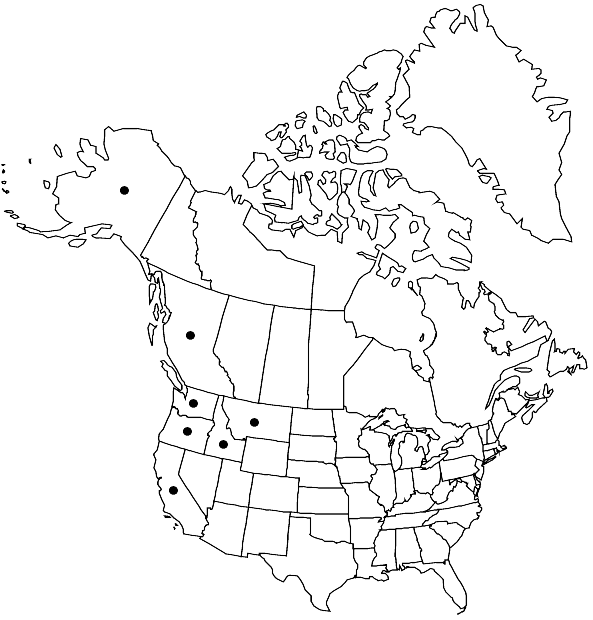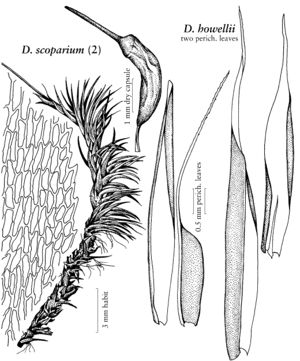Dicranum howellii
Rev. Bryol. 15: 70. 1888,.
Plants in loose to dense tufts, green to yellowish green, glossy. Stems 2–8 cm, densely tomentose with white to reddish brown rhizoids. Leaves falcate-secund to straight and erect, sometimes slightly crisped, smooth, (5–)8–10(–12) × 0.8–1.5 mm, concave proximally, keeled or tubulose above, lanceolate, apex acute; margins strongly serrate in the distal part, entire proximally; laminae 1-stratose; costa ending before apex to shortly excurrent, 1/12–1/5 the width of the leaves at base, with 2, rarely 4, toothed ridges on the abaxial surface extending from about the leaf middle nearly to the apex, rarely almost smooth, with a row of guide cells, two thin stereid bands, adaxial epidermal layer of cells not differentiated, the abaxial layer interrupted by several enlarged cells that form part of the abaxial ridge, not extending to the apices; cell walls between lamina cells not bulging; leaf cells smooth; alar cells 2-stratose, well-differentiated, sometimes extending to costa; proximal laminal cells linear-rectangular, pitted, (52–)65–105(–120) × (10–)12–18(–22) µm; distal laminal cells shorter, sinuose, pitted, (42–)54–90(–108) µm × (10–)12–14(–16) µm. Sexual condition pseudomonoicous or dioicous; dwarf males on rhizoids of female plants or male plants as large as females and growing intermixed or in ± separate tufts; perichaetial leaves gradually acuminate, not or partially convolute-sheathing. Seta 1.5–4 cm, solitary, sometimes 2 per perichaetium, yellow to reddish brown. Capsule 2–3.8 mm, arcuate, inclined to horizontal, smooth to striate when dry, yellow to dark reddish brown; operculum 2–3.8 mm. Spores 18–26 µm.
Phenology: Capsules mature spring.
Habitat: Soil, humus, humus over rock, rotting logs and stumps, tree trunks and bases of trees, sometimes in bogs
Elevation: 20-600 m
Distribution

B.C., Alaska, Calif., Idaho, Mont., Oreg., Wash.
Discussion
Dicranum howellii occurrs only in the northwestern part of North America. It is closely related to the common and nearly ubiquitous D. scoparium. The shape of the interior perichaetial leaves is the most reliable way to distinguish the two. Gradually acuminate perichaetial leaves that loosely surround the seta are characteristic of D. howellii. Dicranum scoparium has abruptly acuminate exterior perichaetial leaves, interior ones that are abruptly acuminateto blunt at the apex and are convolute-sheathing around the seta. The interior perichaetial leaves of D. howellii are also longer and narrower than those of the D. scoparium. Other less significant features of D. howellii are the consistently glossy, long leaves, mostly 8–10 mm, with long distal cells, averaging 54–90 µm, and the common occurrence of only two, rarely four, serrated ridges on the abaxial surface of the costae. Dicranum scoparium by comparison has glossy to sometimes dull leaves that are often shorter, mostly 5–8.5 mm, with shorter distal cells, averaging 27–43 µm, and the costae usually have four, rarely two, serrated ridges on the abaxial surface. The perichaetial leaves are undoubtedly the most important feature separating the two species, as well as being the easiest to observe. Eastern North American plants of D. scoparium all have the abruptly acuminate perichaetial leaves that are characteristic of the species, as do plants elsewhere in the world. The perichaetial leaf character was one reason D. howellii was believed to be a distinct species by F. Renauld and J. Cardot (1889, plate 12B) who first illustrated that character and this remains the most significant reason for maintaining it as a distinct species.
Selected References
None.
